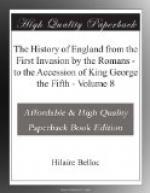[Sidenote a: A.D. 1651. Feb. 21.] [Sidenote b: A.D. 1651. May 27.] [Sidenote c: A.D. 1651. July 3.] [Sidenote d: A.D. 1651. July 13.] [Sidenote e: A.D. 1651. July 17.] [Sidenote f: A.D. 1651. July 21.] [Sidenote g: A.D. 1651. August.]
In the Scottish leaders the progress of the English excited the most fearful anticipations; to Charles it suggested the execution of what had long been his favourite object. The country to the south was clear of the enemy; and a proclamation[a] to the army announced his resolve of marching into England, accompanied by such of his Scottish subjects as were willing to share the fortunes and the perils of their sovereign. The boldness of the attempt dazzled the judgment of some; and the confidence of the young king dispelled the apprehensions of others. Their knowledge that, in case of failure, he must expect to meet with the same fate as his father, justified a persuasion that he possessed secret assurances of a powerful co-operation from the royalists and the Presbyterians of England. Argyle (nor was it surprising after the decline of his influence at court) solicited and obtained permission to retire to his own home; a few other chieftains followed his example; the rest expressed their readiness to stake their lives on the issue of the attempt, and the next morning eleven, some say fourteen, thousand men began[b] their march from Stirling, in the direction of Carlisle.[1]
Cromwell was surprised and embarrassed. The Scots had gained three days’ march in advance, and his army was unprepared to follow them at a moment’s notice. He wrote[c] to the parliament to rely on his industry and despatch; he sent[d] Lambert from Fifeshire with three thousand cavalry to hang on the rear, and ordered[e]
[Footnote 1: Leicester’s Journal, 110. Whitelock, 501. Clarendon, iii. 397.]
[Sidenote a: A.D. 1651. July 30.] [Sidenote b: A.D. 1651. July 31.] [Sidenote c: A.D. 1651. August 4.] [Sidenote d: A.D. 1651. August 5.] [Sidenote e: A.D. 1651. August 7.]
Harrison with an equal number from Newcastle, to press on the flank of the enemy; and on the seventh day led his army of ten thousand men by the eastern coast, in the direction of York. The reduction of Scotland, a more easy task after the departure of the royal forces, was left to the activity of Monk, who had five thousand infantry and cavalry under his command.
So rapid was the advance of Charles, that he traversed the Lowlands of Scotland, and the northern counties in England, without meeting a single foe. Lambert had joined Harrison near Warrington; their united forces amounted to nine thousand men; and their object was to prevent the passage of the Mersey. But they arrived[a] too late to break down the bridge; and, after a few charges, formed in battle array on Knutsford Heath. The king, leaving them on the left, pushed forward till he reached[b] Worcester, where he was solemnly proclaimed by the mayor, amidst the loud acclamations of the gentlemen of the county, who, under a suspicion of their loyalty, had been confined in that city by order of the council.[2]




